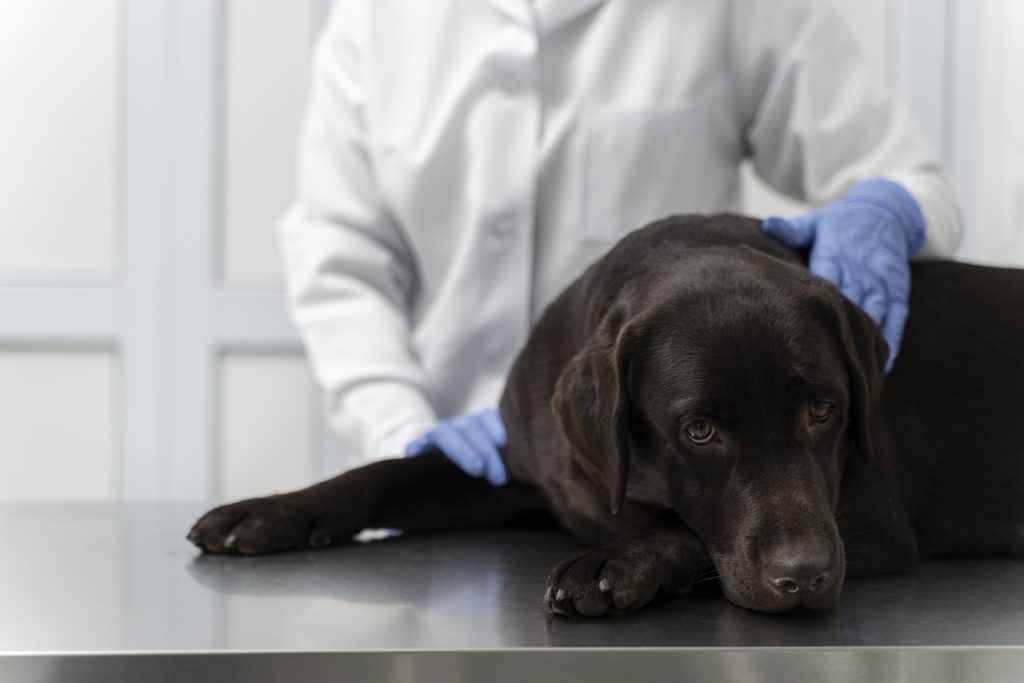Unfortunately, dogs can’t tell us when something hurts. And while pain management for pets has improved greatly over the past decade, the real challenge lies in recognising the signs before treatment can begin. Because dogs often hide discomfort instinctively, it isn’t always easy to tell when they’re in pain. To better understand and recognize pain, we will discuss acute and chronic pain in this article, and the signals that can be seen in one or the other. By learning to recognize signs early, you can catch pain in its earliest stages and make sure your dog gets the care they need.
Acute and Chronic Pain
Acute pain has a sudden onset and usually lasts only a short period of time. It is most often seen after an injury, surgery, or sudden illness, and its purpose is to protect the affected area while it heals. A dog experiencing acute pain often shows clearer signals than those with chronic pain, such as sudden limping or an increase in vocalisation like yelping. Depending on the underlying cause, acute pain can also develop into chronic pain.
Chronic pain, on the other hand, is often less obvious but can cause significant stress for your dog and greatly impact their quality of life. Because symptoms usually begin very subtly, many dogs end up tolerating chronic pain for a long time before it is recognised. Chronic pain is persistent, and without proper management it will progress over time.
A common example is chronic pain in older dogs. Signs like stiffness, reluctance to walk, or difficulty getting up are often dismissed as a normal part of ageing, when in fact they may indicate arthritis, which is the leading cause of chronic pain in senior dogs.
Another example is dental disease, which often goes unnoticed until it is advanced and causing severe symptoms, such as a refusal to eat.
Changes in mobility
One of the more obvious signs that a dog may be in pain is a change in their mobility. This can happen suddenly, such as when a dog begins limping, or gradually, such as when they have increasing difficulty getting up over time.
A few signs of changes in mobility that may indicate pain or discomfort are:
- Refusing to walk, or walking slower and stiffer than normal
- Refusing or reluctant to squat
- Difficulty getting up or laying down.
- Limping
- Reluctance to make a jumping motion, for example not wanting to jump on the sofa or bed, or not wanting to go up the stairs.

Physical Signs
he way a dog carries its body can reveal a lot about their well-being. There are several common physical signs that may indicate a dog is in pain or discomfort. These include:
- Trembling
- Shaking
- Holding the head low
- Holding the tail low
- Having the back arched
- Twitching muscles
- Panting while in rest
- Flattened ears
- Having large pupils and/or glazed wide-eyed look
- Grimacing
Behavioural changes
It’s not uncommon for dogs in pain or discomfort to show sudden shifts in behaviour, and a thorough exam is important to rule out any underlying medical issues.
Common behaviour changes that may indicate pain include:
- Change in sleeping habits
- Change in eating habits
- Increased vocalisation, such as yelping, groaning, whining, howling, or grunting.
- Self-mutilation such as excessive licking, biting, or scratching.
- Restlessness
- Aggression
- Not wanting to be touched, sudden snapping,
- Being grumpy
- House Soiling
- Seeking more attention than normal
- Sudden hiding
Treatment
If you suspect your dog is in pain, it should always be investigated by a veterinarian. They can determine the underlying cause and provide treatment where possible. Your vet can also prescribe the right pain medication at the correct dosage. Never give your dog pain medication meant for humans, as some can be toxic to dogs.
Conclusion
To give our dogs the care they need, we must be able to recognise the signals of pain they show us. When pain is chronic, these signals are often subtle, which makes them easy to overlook. Noticing and investigating even small changes in posture, mobility, or behaviour can help prevent unnecessary stress and suffering for your dog.
If you would like more information about our dog sitting, dog walking or dog relocation services, feel free to contact us.

